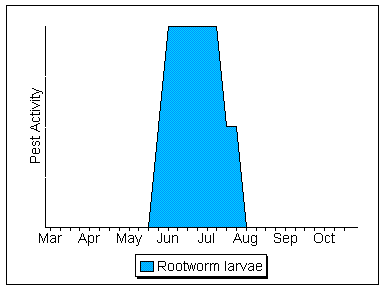Corn Rootworm Beetles
Corn Rootworm Beetles
Description
Three species of corn rootworm beetles are found in Kentucky.

Southern corn rootworm beetle
University of Kentucky Dept. Entomology
Larvae of all three species of corn rootworms have cylindrical white to cream bodies with a brown to black head and a pair of small legs on each of the first three segments behind the head. There is a small brown or black area on the top of the last segment. Full grown (last instar) larvae are about 1/2 inch long.
Northern Corn Rootworm
The northern corn rootworm adult is pale green to yellow and about 1/4 inch long.
Southern Corn Rootworm
The southern corn rootworm adult (also called the spotted cucumber beetle) is about 3/8 inch long. It is yellow-green with 11 conspicuous black spots on the wing covers.
Western Corn Rootworm
The western corn rootworm beetle
is yellow with three black stripes on the wing covers. It is relatively new in Kentucky. If you suspect them in a field, collect some for identification.
Damage
Larvae
Rootworm larvae feed on corn roots for about three weeks. As a result, corn leaves may develop a yellow cast and plants may show symptoms of nutrient deficiency or drought stress due to root damage by the time the corn height reaches knee-high. Infestations may be limited to rough circular areas within fields. Damage may occur in fields that were in corn the previous year. Corn plants may lodge, or fall over, if enough root damage occurs.
Soil compaction, drought stress and other factors can produce symptoms similar to rootworm damage. The presence of rootworm larvae should be confirmed by examining root systems for larvae and chewing damage.
Adults
Adult rootworm beetles feed on the developing corn silks. This is of concern only if adults are present in the field before and during the maximum period of pollen shed. If the field will be planted in corn again the following year, northern and western corn rootworm beetles pose a threat in that larvae will be present in the soil, ready to attack the next year's crop. Southern corn rootworms are important only as silk feeders.
Pest Activity
Larvae

Please note: These dates are approximations only. This calendar was constructed using data from Kentucky, USA. These dates may not apply in your area. You may wish to contact your county extension agent or agricultural consultant for information tailored to your locality.
IPM Techniques and Scouting Procedures
Larvae
Rootworm larvae may be found from mid- through late June. Watch for irregular growth patterns and stress symptoms.
To scout for rootworm larvae:
- Dig up a 6" cube of soil containing the root zone of stressed plants. Carefully break away the soil from around the root zone and look for rootworm larvae and evidence of chewing on the plant roots.
- Indicate infested areas of the field on a field map. If you encounter lodging, record the percentage of lodged plants in random areas of the field. This is done by examining groups of 20 consecutive plants and recording the number bent or lodged. Compute the percentage as explained in the cutworm section.
- Immediately inform your supervisor if you find rootworm damage in a field. Soil compaction, drought stress and other factors can produce symptoms similar to rootworm damage. Confirm your diagnosis by examining root systems for larvae and chewing damage.
Adults
Look for adult rootworm beetles from mid-July through silking. Silk feeding is a problem only if it occurs before and during the maximum period of pollen shed.
If you do not see any beetles as you walk through the field, do not spend your time surveying. However, if beetles are active, follow these guidelines.
- Make counts on 20 plants from each location beginning with random selection of an initial plant. Make counts on every third or fourth plant until 20 plants per location are examined.
- Rootworm beetles fly readily when disturbed so approach each plant carefully. Count the beetles on the ear tip, tassel, leaf surfaces and behind the leaf axil. Record the number of northern and western corn rootworm adults present. Make sure you record beetles found as Northern or Western rootworm adults. Southern corn rootworms are important only as silk feeders.
- Note percent of silks clipped back to 1/2 inch or less.
Economic Threshold
Treatment may be necessary if silks are clipped back to 1/2 inch or less before 50% of the plants are pollinated, and five or more beetles are present per plant.
Note: Your counts of northern and western corn rootworm beetles are used to make soil insecticide recommendations for the following year. If your counts of western and/or northern corn rootworm beetles approach or reach an average of 20 beetles per 20 plants (l per plant), the farmer will be advised to apply a rootworm insecticide if the field is to be planted in corn next year.
References and Additional Information
- IPM-2 Kentucky Corn IPM Manual
- Current Western Corn Rootworm Degree Day Totals for Kentucky


